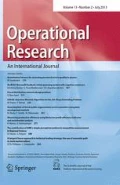Abstract
This paper develops a multi-stage data envelopment analysis congestion model to measure the efficiency and congestion of supply chain. Congestion is said to occur when the output that is maximally possible can be increased by reducing one or more inputs without improving any other input or output. There are no models dealing with supply chain congestion, however we modify one stage Fare, Grosskopf and Lovell approach that proceeds in two stages into multi-stage data envelopment analysis models.We first examine closed loop serial supply chain processes where each stage has its own inputs and at the same time uses carryover inputs from the previous stage. This is the case for all the intermediate stages but not for the polar stages. For instance, the first stage that constitute the supplier stage do not have any carryover inputs as it is the polar stage of the closed loop supply chain. We show that breaking down the production processes of supply networks for evaluation can generate more practical insights in how to eliminate inefficiency in the supply.

Similar content being viewed by others
References
Ballou R, Stephen M, Mukherjee A (2000) New managerial challenges from supply chain opportunities. Ind Mark Manag 29(1):7–18
Blackwell RD (1997) Supply chain strategy: its impact on shareholder value. Int J Logist Manag 10(1):1–10
Brockett P, Cooper W, Shin H, Wang Y (1998) Inefficiency and congestion in chinese production before and the 1978 economic reforms. Socio Econ Plan Sci 32:1–20
Brynes P, Fare R, Grosskopf S (1984) Measuring productive efficiency: an application to illinois strip mines. Manag Sci 30:671–681
Brynes P, Fare R, Grosskopf S, Lovell C (1988) The effect of union on productivity: us surface mining of coal. Manag Sci 34:1037–1053
Castelli L, Pesenti R, Ukovich W (2001) Dea-like models for efficiency evaluations of specialized and interdependent units. Eur J Oper Res 132:274–286
Charnes A, Cooper WW, Rhodes E (1979) Measuring the efficiency of decision-making units. Eur J Oper Res 3:339–339
Chen CM (2009) A network-dea model with efficiency measures to incorporate the dynamic effect in production networks. Eur J Oper Res 194(3):687–699
Chen CM, Dalen JV (2010) Measuring dynamic efficiency: theories and an integrated methodology. Eur J Oper Res 203(3):749–760
Chen Y, Cook WD, Li N, Zhu J (2009) Additive efficiency decomposition in two-stage dea. Eur J Oper Res 196:1170–1176
Chopra S, Meindl P (2004) Supply chain management. Pearson Prentice-Hall, NJ
Cooper W, Seiford L, Zhu Z (2004) Handbook on data envelopment analysis. Kluwer, Dordrecht
Cooper W, Thompson R, Thrall R (1996) Introduction: extension and new developments in dea. Ann Oper Res 66:3–45
Cooper WW, Gu B, Li S (2001) Comparisons and evaluation of alternative approaches to the treatment of congestion in dea. Eur J Oper Res 132(4):62–74
Davenport T, Short J (1990) The new industrial engineering: information technology and business process re-design. Sloan Manag Rev 4(31):11–27
Fare R, Grosskopf S (1983) Measuring congestion in production. Zeitschrift fur Nationalokonomie 43:257–271
Fare R, Grosskopf S (1998) Congestion: a note. Socio Econ Plan Sci 33:21–23
Fare R, Grosskopf S, Lovell C (1985) The measurement of efficiency of production. Kluwer, Dordrecht
Kao C, Hwang SN (2008) Efficiency decomposition in two-stage data envelopment analysis: an application to non-life insurance companies in taiwan. Eur J Oper Res 185(1):418–429
Liang L, Wade DC, Zhu J (2008) Dea models for two-stage processes: game approach and efficiency decomposition. Naval Res Logist 55(7):643–653
Quanling W, Hong Y (2009) Weak congestion in output additive data envelopment analysis. Socio Econ Plan Sci 43:40–54
Tone K, Sahoo B (2004) Degree of scale economies and congestion: a unified dea approach. Eur J Oper Res 158:755–772
Tone K, Tsutsui M (2009) Network dea: a slacks-based measure approach. Eur J Oper Res 197(1):243–252
Tyndall F, Kamauff GW (1998) Global supply chain management. Wiley, New York
Wei Q, Yan H (2004) Congestion and returns to scale in data envelopment analysis. Eur J Oper Res 153:641–660
Acknowledgment
This project was supported by Korea Maritime University. The authors like to thank the anonymous reviewers for their constructive comments.
Author information
Authors and Affiliations
Corresponding authors
Rights and permissions
About this article
Cite this article
Sharma, M.J., Yu, S.J. Multi-Stage data envelopment analysis congestion model. Oper Res Int J 13, 399–413 (2013). https://doi.org/10.1007/s12351-012-0128-8
Received:
Revised:
Accepted:
Published:
Issue Date:
DOI: https://doi.org/10.1007/s12351-012-0128-8




